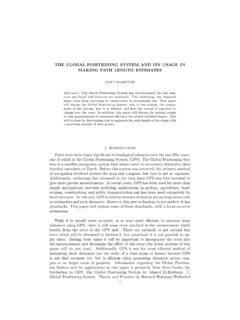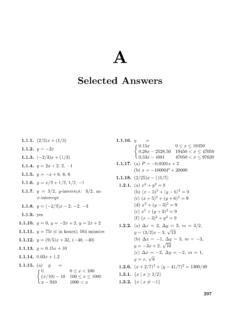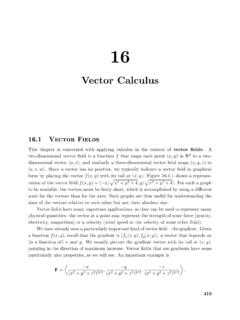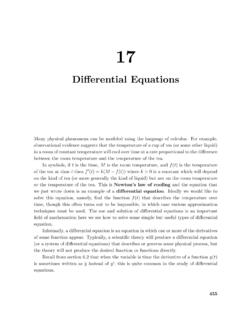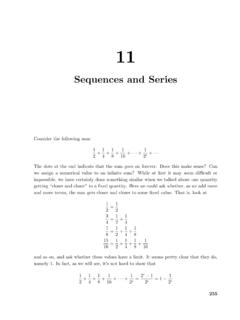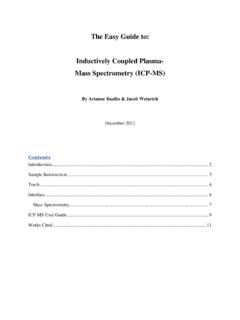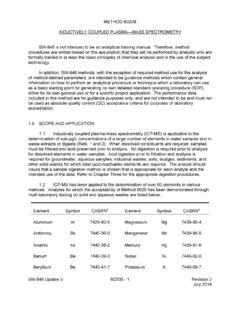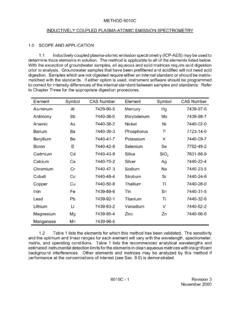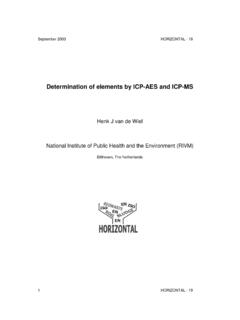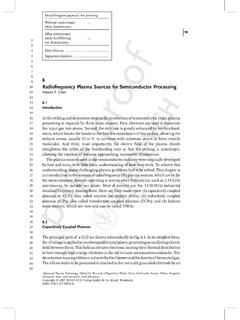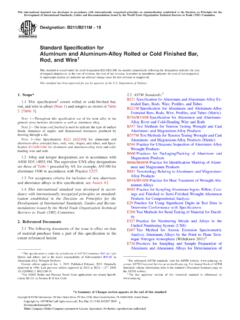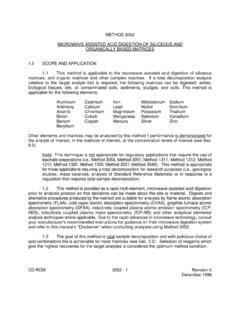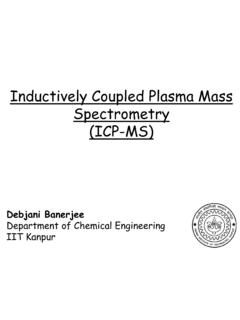Transcription of CHAPTER 4 Inductively Coupled Plasma—Atomic Emission ...
1 CHAPTER 4 Inductively Coupled Plasma Atomic Emission Spectrometry Introduction and History Greenfield et al. developed plasma-based instruments in the mid 1960s about the same time flame-based instruments such as FAAS and FAES ( CHAPTER 2) became prominent (Analyst, 89, 713-720, 1964). These first plasma-based instruments used direct current (DC) and microwave-induced (MI) systems to generate the plasma. Interference effects and plasma instability limited the utility of plasma instruments during analysis; consequently flame-based spectrometry instruments (such as FAAS) dominated the analytical market for metals analysis and remain effective today. The limitations of the first plasma instruments were overcome by utilizing an Inductively Coupled plasma (ICP) instead of DC or MI generated plasma.
2 ICP optical systems became popular in the 1980s due to their decreased cost, lower time investment during analysis, and labor saving advantages. FAAS instruments require a unique radiation source (lamp) for the approximately 35 elements they can measure. Because the lamp must be changed between each element of interest, FAAS (and FAES) techniques analyze a single element at a time and are unable to easily analyze metalloids. ICP optical systems, by contrast, can analyze about 60 different elements at the same time with a single source (the plasma). The most common instruments today are Inductively Coupled plasma atomic Emission spectrometers (ICP-AES) and Inductively Coupled plasma mass spectrometers (ICP-MS). ICP-AES will be discussed in this CHAPTER while ICP-MS will be the subject of the next CHAPTER .
3 Atomic Emission Spectrometry Theory The operation of an ICP-AES system relies upon the same interaction of molecules with electromagnetic radiation that was presented in CHAPTER 1. The two Emission systems, FAES and ICP-AES, differ in the way atomic species are created and excited. Because of the relatively low temperatures (~2000-2500 C) in a flame-based system, not all of the atoms or elements present in the sample are excited, particularly if they exist in a polyatomic compound. Some elements readily form non-emitting and refractory oxides that result in an underestimation of their concentration. In plasma-based systems the temperature is considerably hotter (~10 000 K for Ar ICP) that results in more effective excitation of atoms (generally greater then 90%) of approximately 60 elements including some nonmetals.
4 This intense heat prevents polyatomic species from forming, thus increasing the detection limits for many elements. Atoms are excited, and in many cases ionized, by the intense heat of the plasma, and the Emission of a photon occurs via resonance fluorescence (normal valance electron relaxation by photon Emission ). While plasma-based systems eliminate many problems, they are not free of interferences due to the excitation and subsequent Emission of spectral lines for every element in the sample as well as the Ar added to facilitate plasma generation. The spectral overlay that results from these possible emissions is overcome in modern instruments with specialized sequential monochromators (Section ). ICP-AES, compared to FAAS/FAES, offers high selectivity between elements, high sensitivity, a large dynamic range, especially as compared to FAAS that is limited by Beer s law, lower detection limits, multi-element detection, and fewer matrix interferences.
5 Components of an Inductively Coupled Plasma Atomic Emission Spectrometry System (ICP-AES) Overview: An ICP-AES system can be divided up into two basic parts; the Inductively Coupled plasma source and the atomic Emission spectrometry detector. Figure shows the common components of an ICP-AES system from the late 1980s to the 1990s. The Inductively Coupled plasma source has mostly been unchanged since its invention with the exception of innovation in monochromator type, which enables greater suppression of interference phenomena. Modifications of this common system will be explained in the following sections. Sample solutions include digested soil or other solid material or natural water. Typically the sample solution is acidified up to 2-3% in HNO3 to prevent adsorption of metals onto polypropylene sample bottle or onto instrument tubing or glassware prior to introduction into the plasma.
6 In Figure 3-1, the sample is introduced to the nebulizer chamber via a peristaltic pump and tygon tubing attached to an automatic sampler. A peristaltic pump operates by sequentially compressing flexible tubing with evenly spaced and rotating rollers that pull/push the liquid through the system. The rate of sample introduction into the plasma changes as the rotation rate of the peristaltic rollers increases or decreases. Flow of sample and Ar gas through the small aperture of the nebulizer creates very small droplets that form a mist of m-sized particles in the nebulizer chamber. Larger sample droplets collect on the chamber walls and are removed through a drain, while smaller particles travel with the Ar flow and enter the torch. Evaporation, atomization, and excitations/ionizations occur in the plasma at temperatures reaching 10,000 K.
7 Ar not related to the sample is also excited and ionized because this gas both carries the sample aerosol and confines the location of the plasma to prevent damage to the rest of the instrument. As the excited/ionized atoms leave the hot portion of the plasma, excited valence electrons relax and emit a photon characteristic of the electron transition. This photon is specific to the element but does not yield any information about the isotopic state of the element, unlike in mass spectrometry ( CHAPTER 5). Visible and UV radiation emitted from the sample constituents enters the monochromator through a small slit where the wavelengths are separated by grating(s) and/or prism(s) before being captured and measured by a wide variety of detectors.
8 Because spectral interferences may still occur, the choice and configuration of the monochromators in the instrument is important and has been the target of innovation. In Figure , the most common form of a monochromator (a Rowland circle) and detector (photomultiplier; PMT) is shown: The Rowland system utilizes a concave Echellette-style grating monochromator to separate the various Emission lines and simultaneously focus individual wavelengths on to a series of slits, with each slit aligned to allow a specific wavelength of radiation to pass to a detector. The standard detector, a photomultiplier tube (PMT), was discussed in Section Some systems use multiple PMTs at fixed locations to monitor each wavelength simultaneously (Figure 3-1) whereas other systems use a single PMT and move it to different locations to detect each wavelength.
9 Data from these detectors are processed by a computer because multiple wavelengths are measured in an ICP-AES system at the same time. Figure Overview of a Basic Inductively Coupled Plasma Atomic Emission Spectrometry (ICP-AES) from the 1990s. Sample Introduction and Optimization The predominate form of sample matrix in ICP-AES today is a liquid sample: acidified water or solids digested into aqueous forms. Given the automated nature of the ICP analysis, all modern systems are purchased with automatic samplers where a computer-controlled robotic sampling arm takes liquids from each sample via a peristaltic pump from plastic tubes located in specific locations in a sampling tray. Liquid samples are pumped into the nebulizer and sample chamber via a peristaltic pump as shown below.
10 Then the samples pass through a nebulizer that creates a fine mist of liquid particles. Larger water droplets condense on the sides of the spray chamber and are removed via the drain (pumped out of the chamber also by the same peristaltic pump) while finer water droplets move with the argon flow and enter the plasma. Nebulizers help ensure that the sample enters into the plasma at a uniform flow rate and specific droplet size. Droplets that are great than 5 m in diameter are likely to interfere with plasma stability. Figure An Overview of Sample Introduction and the Nebulizer Chamber. (The nebulizer shown here is a pneumatic style, described below.) While there are numerous types of nebulizers for a variety of specific applications, the three most commonly types are the (1) pneumatic, (2) ultrasonic, and (3) grid.
